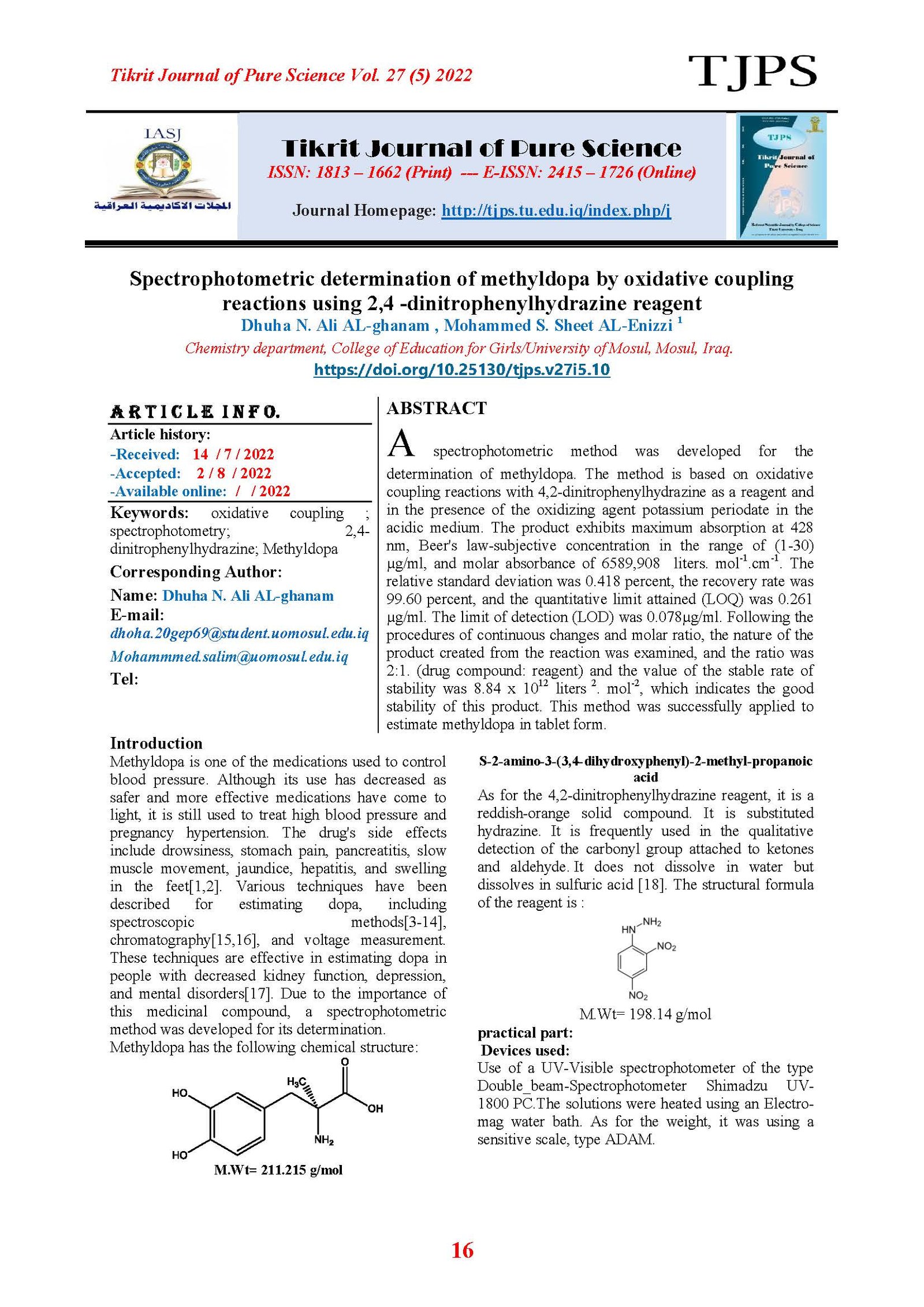Spectrophotometric determination of methyldopa by oxidative coupling reactions using 2,4 -dinitrophenylhydrazine reagent
Main Article Content
Abstract
A spectrophotometric method was developed for the determination of methyldopa. The method is based on oxidative coupling reactions with 4,2-dinitrophenylhydrazine as a reagent and in the presence of the oxidizing agent potassium periodate in the acidic medium. The product exhibits maximum absorption at 428 nm, Beer's law-subjective concentration in the range of (1-30) µg/ml, and molar absorbance of 6589,908 liters. mol-1.cm-1. The relative standard deviation was 0.418 percent, the recovery rate was 99.60 percent, and the quantitative limit attained (LOQ) was 0.261 µg/ml. The limit of detection (LOD) was 0.078µg/ml. Following the procedures of continuous changes and molar ratio, the nature of the product created from the reaction was examined, and the ratio was 2:1. (drug compound: reagent) and the value of the stable rate of stability was 8.84 x 1012 liters 2. mol-2, which indicates the good stability of this product. This method was successfully applied to estimate methyldopa in tablet form
Article Details

This work is licensed under a Creative Commons Attribution 4.0 International License.
Tikrit Journal of Pure Science is licensed under the Creative Commons Attribution 4.0 International License, which allows users to copy, create extracts, abstracts, and new works from the article, alter and revise the article, and make commercial use of the article (including reuse and/or resale of the article by commercial entities), provided the user gives appropriate credit (with a link to the formal publication through the relevant DOI), provides a link to the license, indicates if changes were made, and the licensor is not represented as endorsing the use made of the work. The authors hold the copyright for their published work on the Tikrit J. Pure Sci. website, while Tikrit J. Pure Sci. is responsible for appreciate citation of their work, which is released under CC-BY-4.0, enabling the unrestricted use, distribution, and reproduction of an article in any medium, provided that the original work is properly cited.
References
[1] A. S. Molla, M. Rabbani, M. Sharifzadeh, and A. Hosseini-Sharifabad, (2017), ‘‘Effects of maternal alpha Methyldopa administration on Memory of Rat of spring during Growing Age’’,IJT. 11(1) :43-47
[2] R. Gasnier ,(2016), ‘‘Hypertension in pregnancy-Treatment’’ Austin Hypertens, 1(2): 1007.
[3] M. Q. Al-Abachi, R. Sinan and H. Haddi, (2009), ‘‘Spectrophotometric determination of methyldopa and dopamine hydrochloride in pharmaceutical preparations using flow injection analysis’’, Nati. J. Chem., 36, pp. 597-604.
[4] M. Al-Da’amy and R.F. Al-Moswi, (2014), ‘‘Spectrophotometric determination of methyldopa in pharmaceutical preparation via oxidative coupling organic reaction with para-phenylene diamine in the presence of potassium periodate’’, Malaysia Handbook on the Emerging Trends in Scientific Research, 1, pp. 160-166.
[5] M. Gotardo, L. Lima, H. Pezza, J. Rufino and R. Sequinel, (2008), ‘‘A simple spectrophotometric method for the determination of methyl dopa using p-chloranil in the presence of hydrogen peroxide’’, Ecletiea Quimica, 33(3), pp. 7-12.
[6] I. T. Humeidy, (2016), ‘‘Spectrophotometric determination of methyldopa by oxidative coupling reaction using N,N-dimethylpara phenylene diamine dihydrochloride in presence of potassium ferricyanide (III)’’, Tikrit J. Sci., 60 (1), pp. 1-3.
[7] I. T. Humeidy, S. A. Salman and K. K. Hashim, (2020), ‘‘Spectrophotometric determination of methyl dopa with 2,6- di amino pyridine reagent using oxidative coupling reaction’’, Journal of Engineering Science and Technology, 15 (3), pp. 1824-1839.
[8] E. Gadkariem, K. Ibrahim, N. Kamil, M. Haga and H. El-Obied, (2009), ‘‘A new spectrophotometric method for the determination of methyldopa’’, Saudi pharmaceutical Journal, 17 (4), PP. 289-293.
[9] J. A. Abdulsattar, (2014), ‘‘Exploiting the diazotization reaction of 4-amino aceto phenone for methyl dopa determination’’, Baghdad J. Sci., 11 (1), pp. 139-146.
[10] Q. N. Rashid, M. H. Bakir and S. O. Baban, (2016), ‘‘Spectrophotometric determination of methyl dopa in pure form and in pharmaceutical preparations’’, Tikrit J. Pharm. Sci., 11 (1), pp. 67-77.
[11] A. Abdul-Monem and E. Bahget, (2018), ‘‘Spectrophotometric micro determination of methyl dopa and etilefrine hydrochloride using copper (III) necouproine reagent in pure form and pharmaceutical formulations’’, Scholars research Library Der Pharmacia letter, 10 (8), pp. 17-32.
[12] P. Pibeiro and R. Duarte, (2014), ‘‘Development and validation of a simple spectrophotometric method for the determination of methyl dopa in both bulk and marketed dosage formulations’’, Brazilian Journal of pharmaceutical Sciences, 50 (3), pp. 573-582.
[13] R. Kaushik, R. Yadav, R. Sushma, M. Manila and J. Singh, (2014), ‘‘Development and Validation of kinetic-spectrophotometric method for determination of methyldopa in aqueous formulation and tablets’’, Der. Pharm. Chemica., 6 (4), pp. 102-108.
[14] W. Suhuan, J. Siyue and D. Xiaodong, (2016), ‘‘Study on detection methods for methyldopa in biological samples’’, Int. J. Curr. Res. Chem. Pharm. Sci., 3 (7), pp. 8-11.
[15] M. Dolezalova and M. Tkaczykova, (1999), “Direct high-performance liquid chromatographic determination of the enantiomeric purity of levodopa and methyldopa: comparison with pharmacopoeial polarimetric methods”, J Pharm .Biomed. Anal., 19,3,555-567.
[16] Z. Jin-qil, J. Ju-Zhen, C. Liang-Ping and L. Hui-ling, (2010), “HPLC determination of content of methyldopa and its related substances”,Chin J. Pharm . Anal., 30,1440-1444.
[17] S.S Badawy.,Y.M. Issa,, and, A.S Tageldin.(1996), “Potentiometric determination of L-dopa, carbidopa, methyldopa and aspartame using a new trinitrobenzenesulfonate selective electrode” Electro analysis, ,8,1060
[18] C. F. H. Allen,, (1933), "2,4-Dinitrophenylhydrazine". Organic Syntheses.13: 36.Collective 2: 228.
[19] C. T. Kerren, (1979), “Quantitative analysis”, Macmllian publishing Co.Inc., New York, U. S. A., P.32.
[20] L. G. Hargis, (1988), “Analytical chemistry”, Prentic-Hall. Inc., New Jersey, 424-427.
